Machine learning for business has real potential, but it can feel like a maze. Data sits in silos, systems are outdated, and every choice (build, buy, or partner?) carries its own risk. You really need a roadmap that’s practical, concrete, and easy for your team to follow in order to succeed.
That’s how we work at Aloa. We start with business goals, ship quick prototypes, and plug into your existing tools. Our transparent pricing and ongoing support keep the process simple and reduce risk, so you can show progress fast.
In this guide, we’ll cover where machine learning creates value, the best applications to start with, five strategies that make adoption stick, common hurdles and how to fix them, and the KPIs that prove ROI. By the end, you’ll know how to launch a pilot and get results your stakeholders will trust.
Understanding the Business Value of Machine Learning
Machine learning for business puts your data to work by turning messy inputs into clear insights. It helps you personalize offers, set smarter prices, and make sharper decisions. You’ll cut costs, grow revenue, and gain an edge competitors can’t easily copy, all from data you already own.
Cost Reduction and Efficiency Gains
Every business has tasks that consume time but don’t create much value, such as invoice checks, ticket triage, or scheduling shifts. ML is built for this kind of repetitive, rule-driven work. By automating it at scale, you give your team hours back, boost operational efficiency, and trim expenses without cutting corners. Here's how:
- Routine work shrinks: Instead of a support team manually routing tickets all day, ML models can direct them instantly. Your staff gets to spend their energy solving problems, not shuffling them around. And the gain isn’t just lower costs; it’s higher morale.
- Breakdowns get prevented: Waiting until equipment fails is expensive. ML spots the warning signs early, so you can service a delivery truck before it strands your driver or tune a machine before it halts a production line. Less downtime means steadier output and fewer emergency repairs.
- Resources stretch further: Forecasting models help you right-size staff schedules or inventory. That means fewer wasted shifts, shelves that aren’t overstocked, and cash freed up for more important investments.
Imagine a busy clinic predicting which patients are likely to miss appointments. By filling those gaps early, they keep the schedule tight and revenue steady. The same principle applies anywhere time slots or capacity matter (restaurants, gyms, even consulting firms).
If you’re worried automation means mistakes, keep people in the loop for the edge cases. Let ML handle the heavy volume, with human intervention on the tricky calls.. That way, you're delivering efficiency without losing trust.
Revenue Generation Opportunities
Cost savings protect the bottom line, but growth is what wins the market. ML helps here by anticipating what your customers will do next so you can meet them with the right product, price, or message. Instead of relying on gut instinct, you act with data-backed confidence using business analytics. That means you get:
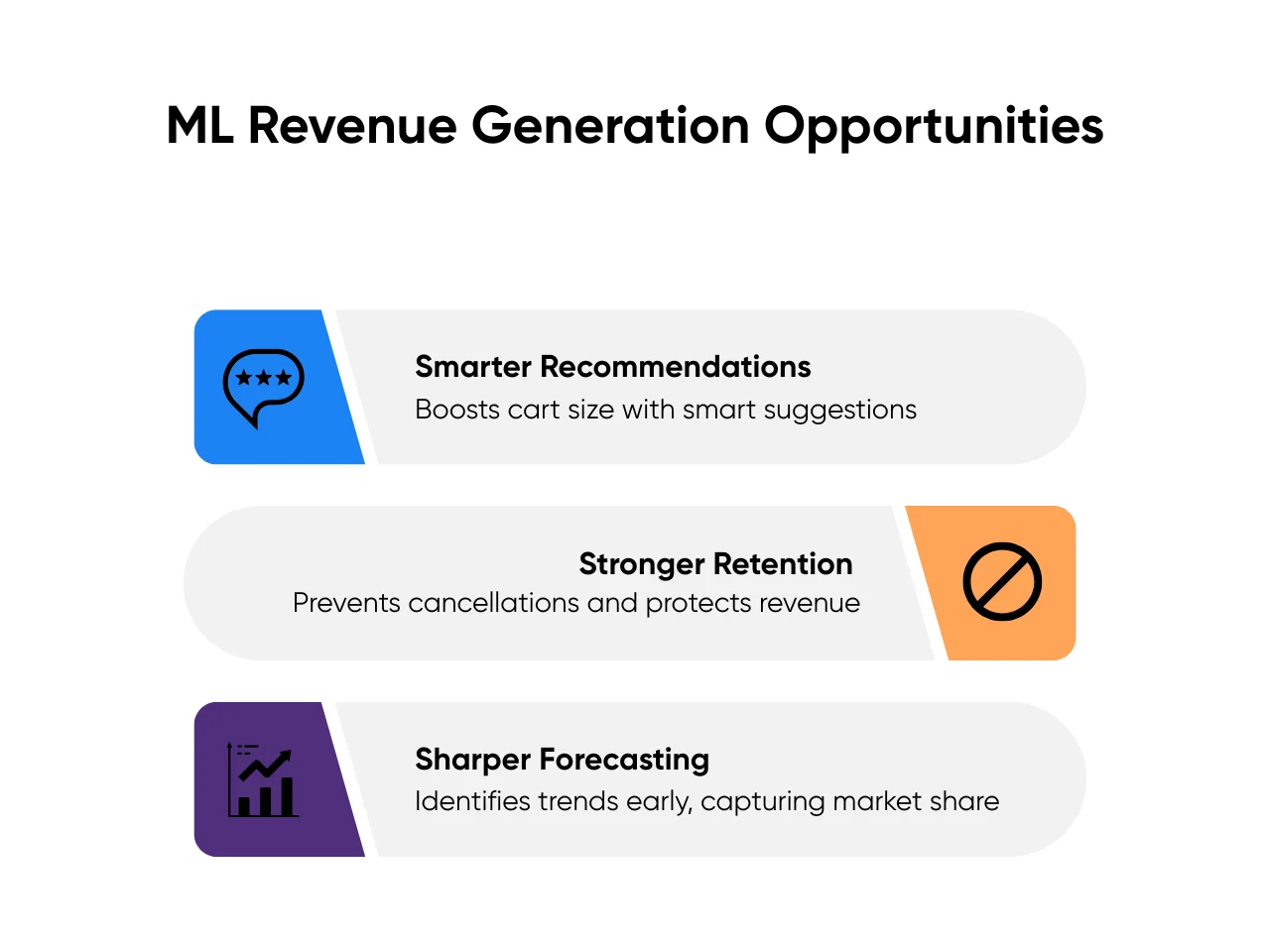
- Smarter Recommendations: An e-commerce site can suggest complementary items, nudging shoppers to add one more thing to their cart. Even a small lift (say 10% higher basket size) compounds quickly when multiplied across thousands of transactions.
- Stronger Retention: A subscription platform can see which users are starting to disengage (maybe they haven’t logged in for a week) and send a targeted nudge before they cancel to protect customer engagement. That quick save protects recurring revenue and keeps customer lifetime value steady.
- Sharper Forecasting: A sales team can use ML to spot demand shifts (like a product category trending up in one region) and double down before competitors notice. Moving early on market trends means capturing share that others miss.
On the lending side, a bank may refine credit scoring with ML. That could result in more qualified loans getting approved and fewer risky ones slipping through. That also means more customers served, more revenue booked, and stronger margins.
Some execs might wave off “AI revenue stories.” That’s why you tie results to familiar numbers like conversion rate, churn, or order value. Dollars and percentages win the argument, not buzzwords.
Competitive Advantage Creation
The real magic of ML is the advantage it builds over time. Cost savings and revenue lifts are great, but the compounding effect is what turns ML into a moat that’s hard for others to cross.
Here’s what that looks like:
- Decisions move faster: A supply chain team forecasting with ML can adjust orders days earlier. That means shelves stay stocked while competitors scramble to catch up.
- Customers stick around longer: Personalized experiences built on customer data keep people loyal. When offers feel relevant (“this brand gets me”), they’re less likely to shop around or churn.
- Systems keep improving: Every new data point sharpens your models. That feedback loop makes your competitive edge grow stronger while slower rivals fall further behind.
Think about a retailer that feeds local sales data, seasonality, and even weather into its forecasting. Over time, the system learns buying patterns unique to that business. A competitor can buy the same tool, but they can’t buy your data or the insights that only your history produces.
Yes, competitors can copy features. But they can’t copy your proprietary data, your tuned processes, or the way your teams act on those insights. That’s what makes ML a lasting edge, not a short-lived gimmick.
Lower costs, higher revenue, and a compounding edge are what make machine learning such a powerful lever for mid-market leaders. At Aloa, we see this across industries: healthcare teams using ML to reduce no-shows, retailers driving larger basket sizes, financial firms refining risk models. The details differ, but the principle is the same. ML delivers when it’s tied to clear business outcomes, not abstract experiments.
But knowing its value is only step one. The bigger question is: where do you actually start? That’s what we’ll unpack next as we look at the most practical applications you can deploy today.
Essential Machine Learning Applications for Business Growth
Once you know ML creates value, you then decide where to apply it. Not every use case is worth your time. The smart move is to start with applications that have clear data, measurable outcomes, and credibility with your stakeholders.
Here are five areas where ML delivers impact fast:
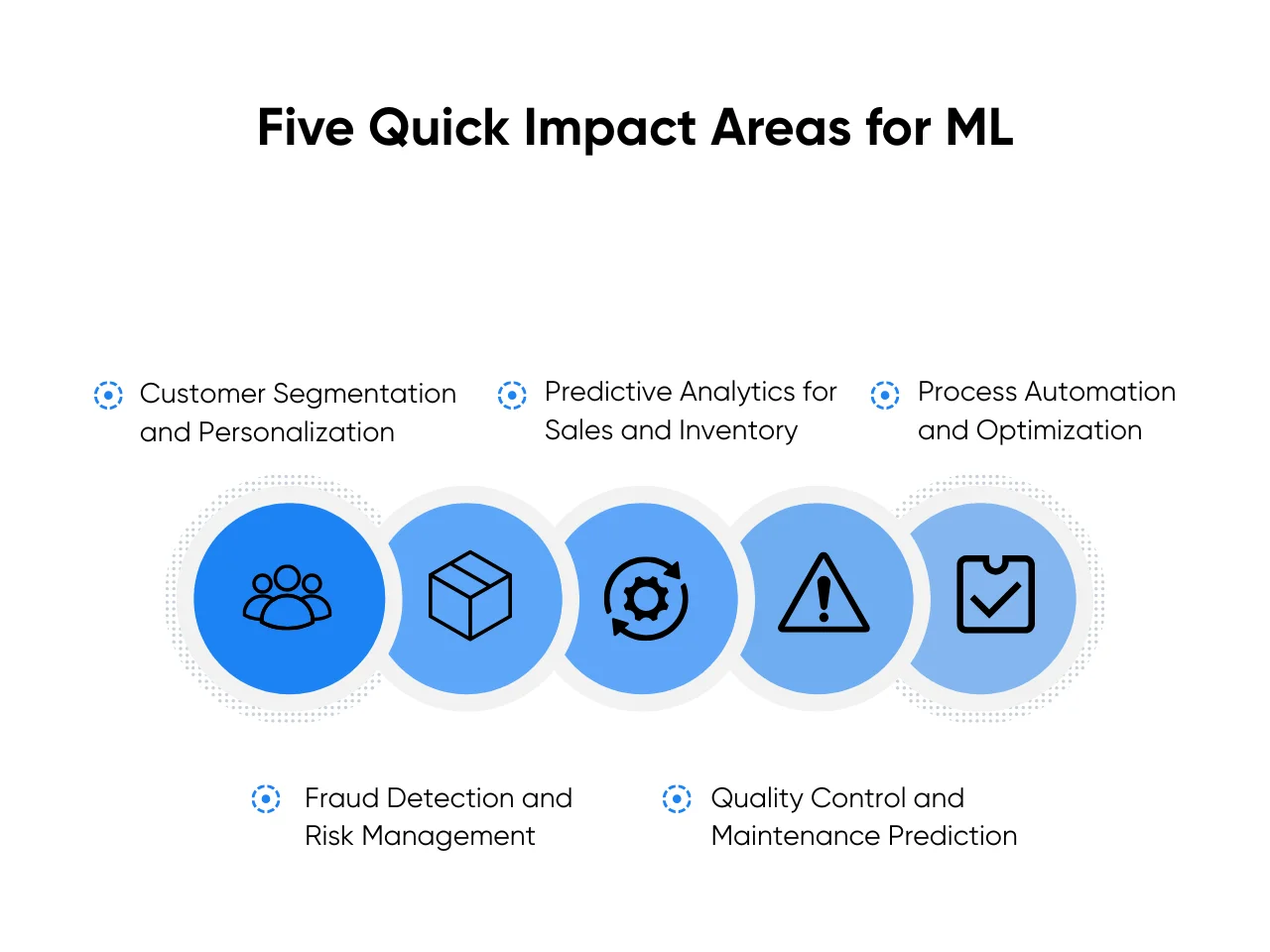
Customer Segmentation and Personalization
Segmentation is about grouping customers so you can serve them better. Traditional methods relied on broad categories like age or income. Machine learning makes it sharper by clustering people based on user behavior: what they browse, when they buy, how often they engage. That turns rough guesses into actionable insight.
In practice, that means:
- Smarter Targeting: A retailer can use past purchase patterns and social media signals to decide which promotions go to which customers. The right offer lands in the right inbox, and conversion rates climb without bigger ad budgets.
- Better Timing: Instead of sending campaigns at the same time for everyone, ML can identify when each customer is most likely to open an email or click an ad. A small lift in engagement at scale translates into meaningful revenue.
- Personalized Experiences: Online stores or apps can recommend the next product a customer is likely to want, powered by machine learning techniques on large datasets. Even a 10% bump in basket size adds up quickly across thousands of transactions.
Customers get offers and experiences that feel relevant, and your team captures more value from the same campaigns. That sets the stage for the next high-impact area: using ML to sharpen forecasts for sales and inventory.
Predictive Analytics for Sales and Inventory
Forecasting isn’t new. Every sales leader and operations manager has done it. What changes with ML is the level of precision from statistical models and deep learning. Instead of rough guesses, you get patterns pulled from real history, like seasonality, regional demand shifts, even how external factors like weather affect buying. That means:
- Sales gets more reliable targets: Reps and managers plan around demand that actually exists instead of gut feel. That keeps quotas realistic and resources aligned where they’ll pay off.
- Inventory stays balanced: Operations teams can stock enough to meet demand without over-ordering. That frees up cash and avoids the hit of excess product sitting idle.
- Promotions align with demand: Marketing can tie campaigns to periods of expected spikes, squeezing more out of each dollar spent.
And the numbers add up fast. Companies using predictive analytics have cut forecasting errors by 20–30% and lifted profits by 5–10%. Even smaller gains, when applied across multiple products and regions, can translate into significant savings and recovered sales.
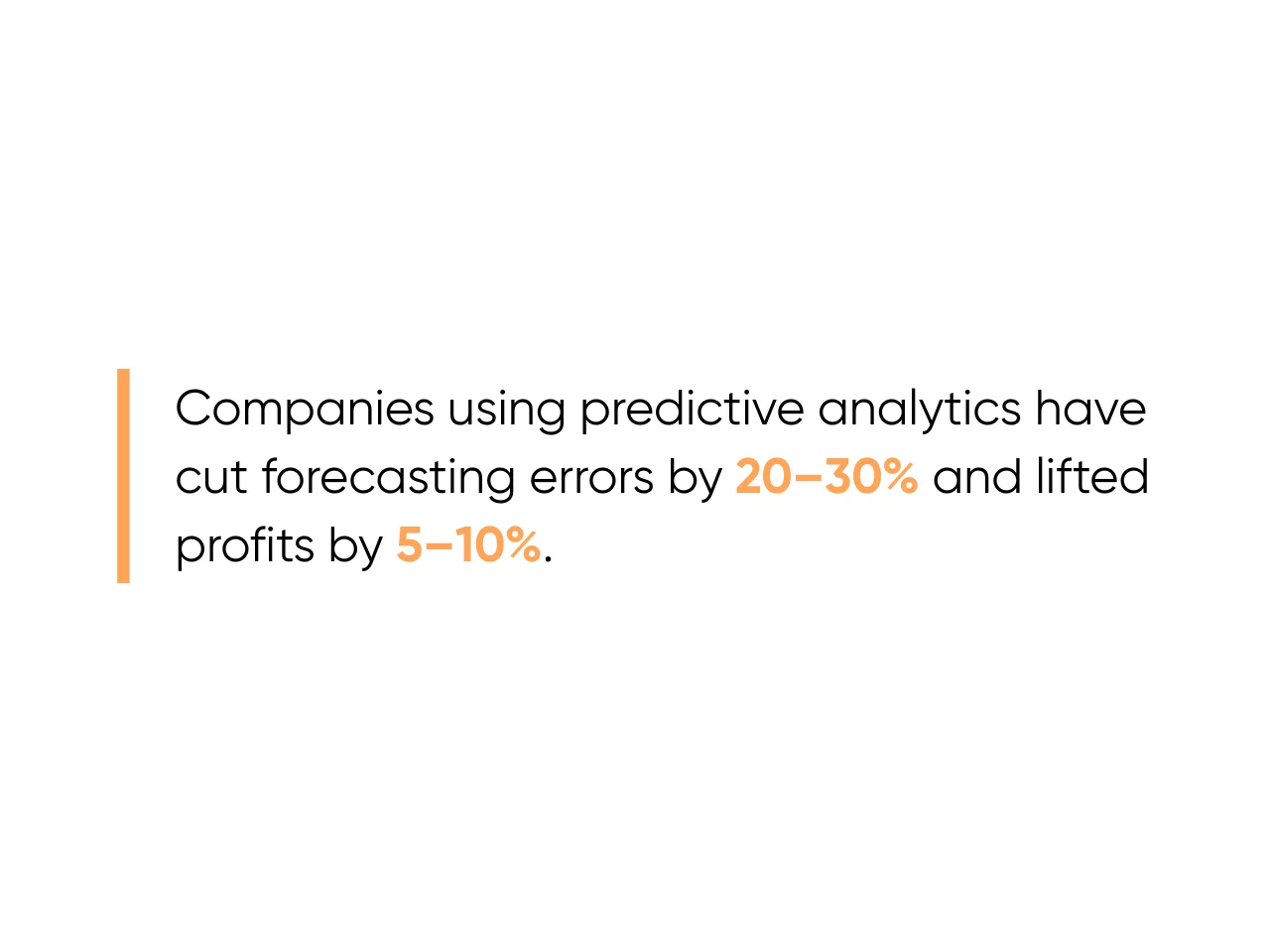
But the real benefit? Sales, operations, and marketing stop working off different playbooks. With shared, data-backed forecasts, the whole business moves in sync.
Process Automation and Optimization
Repetitive tasks drain morale and budget. Machine learning is well suited for these because it can spot patterns, make simple decisions, and free your people to focus on higher-value work.
Think of tasks like:
- Routing Tickets: Instead of support staff spending hours sorting requests, ML can direct each ticket to the right team instantly. Customers get faster responses, and agents spend their energy fixing issues rather than sorting them.
- Matching Invoices: Finance teams no longer have to manually line up purchase orders with invoices. ML handles the matching automatically, reducing cycle time and cutting down on human error.
- Sorting Claims: In insurance, ML can flag straightforward claims for quick approval and route complex ones to specialists. That means faster payouts for most customers and more focus where human judgment matters.
The best way to approach process automation is one workflow at a time. Pick a process, measure cycle time and error rates, then roll out the ML solution. Once you see shorter turnaround, lower costs, and happier teams, you’ll have the proof points to expand.
Fraud Detection and Risk Management
Fraud is expensive, but so are false alarms. If you block too much, you frustrate good customers. If you miss too much, you eat the losses. Machine learning helps find the middle ground by spotting patterns that don’t fit the norm and flagging them before they turn costly.
Two examples bring it into focus:
- Finance Teams: Transactions are scanned in real time. ML can separate truly suspicious activity from everyday anomalies, catching fraud and reducing security breaches without drowning analysts in false positives. Customers swipe, pay, and move on without unnecessary friction. Banks are already deploying this at scale.
- Insurance Providers: Claims get scored by risk. Low-risk cases move quickly, keeping honest customers happy with faster payouts. High-risk ones surface for investigators to ensure time is spent where it makes the biggest difference.
This gives you balance. You prevent losses, keep legitimate customers moving smoothly, and give your team a system that learns and improves with every new case.
Quality Control and Maintenance Prediction
Defects and downtime are double hits: one eats customer trust, the other stops revenue cold. Neither should come as a surprise, yet they often do. ML helps by turning production data and sensor signals into early warnings you can act on. This way:
- Quality checks scale: A human inspector might miss a flaw after staring at the line for hours. Computer vision doesn’t blink. ML scans every product in real time, catching defects before they ship. That means fewer returns, less rework, and customers who get what they paid for.
- Downtime shrinks: Machines rarely fail without warning. They vibrate differently, run hotter, or use more power first. ML picks up those signals and alerts you to schedule service before failure. Fixing a machine on your terms avoids emergency repairs and can cut unplanned downtime by 15% or more.
Your factory gets to keep production rolling because its biggest press gets serviced over the weekend instead of breaking down mid-shift. The same principle applies anywhere reliability matters, whether it’s keeping a fleet of delivery trucks on the road or medical devices up and running.
If you worry about false alarms, build in a human checkpoint. Let ML do the heavy lifting of flagging issues, and let people decide which ones warrant action. That balance keeps efficiency gains high without adding noise.
Each of these applications shares one trait: they solve practical business problems you can measure. That’s why they make strong pilot candidates. At Aloa, we help leaders zero in on the right use cases, like scheduling in healthcare, fraud detection in finance, or personalization in retail, then prove value before scaling.
5 Proven Machine Learning Strategies
Applications show what’s possible. Strategies show how to actually get there. Without a plan, ML pilots drift, teams lose patience, and stakeholders stop believing in the value. These five approaches will keep you focused and moving:
1. Start With the Right Business Problem
The first trap most teams fall into is chasing the cool use case instead of the useful one. Just because ML can be applied somewhere doesn’t mean it should. You don’t get credit for experimenting; you get credit for solving problems your business leaders care about.
The right problem usually checks three boxes:
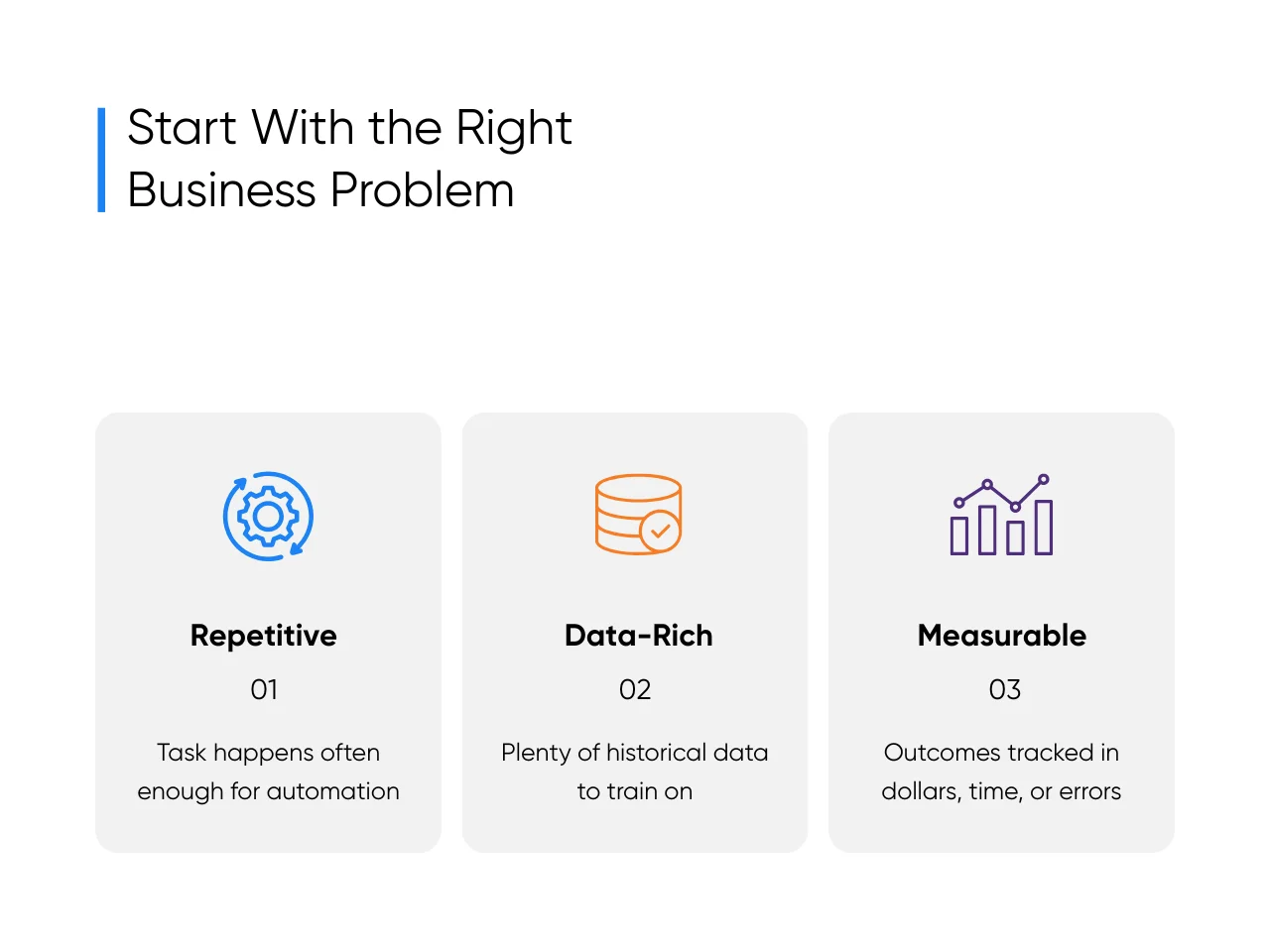
- Repetitive: The task happens often enough to warrant automation.
- Data-Rich: You already have a steady stream of historical data to train on.
- Measurable: The outcome can be tracked in dollars, time saved, or errors avoided.
Think about reducing support ticket backlogs. If your help desk logs thousands of tickets a month, routing them automatically frees up staff hours and cuts response times. Or take demand forecasting: predicting sales of a popular product line helps operations plan inventory and avoid costly stockouts. Risk teams can benefit too: flagging high-risk transactions before they’re processed saves real money and keeps fraud down.
Where does ML not fit? Problems that hinge on creativity (like product design), fuzzy or inconsistent data (like brainstorming notes), or outcomes no one can measure. If you can’t tie success to a KPI your CFO already tracks, it’s not the right candidate (see AI for business courses for scoping frameworks).
2. Get Your Data House in Order
Messy data is the number-one ML killer. It doesn’t matter how advanced your model is. If the input is bad, the output will be worse. Before building anything, focus on cleaning and structuring the raw data you already have. That might mean:
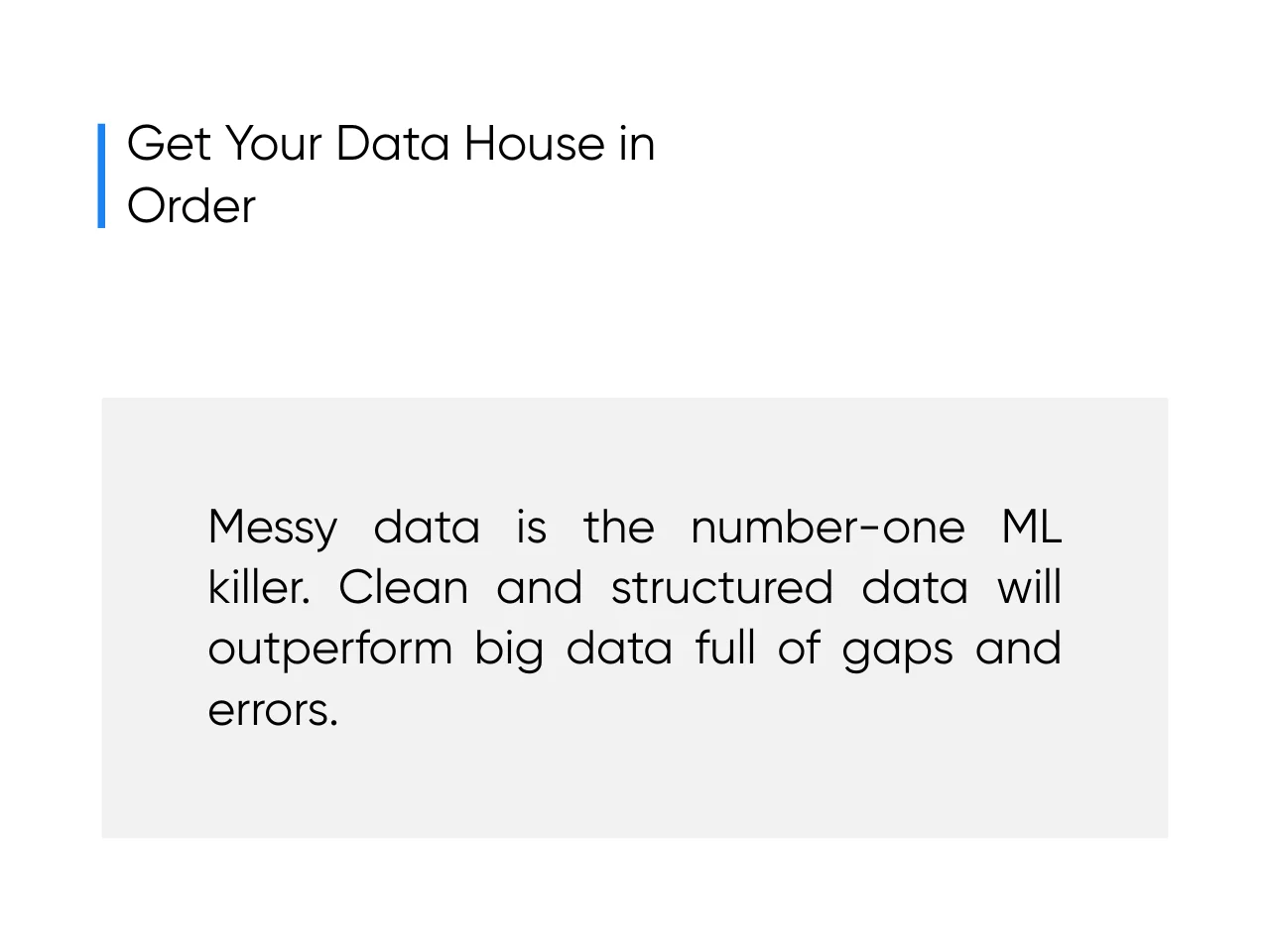
- Pulling customer records together from multiple systems so you’re not working with duplicates
- Standardizing how sales reps enter deal information so every pipeline report uses the same fields
- Fixing mismatched entries in your ERP so inventory, billing, and fulfillment actually line up
The point isn’t to chase “big data.” You don’t need billions of records to get started; you need good data. A smaller dataset that’s accurate and consistent will outperform a massive one full of gaps, errors, and inconsistencies.
ML models work like training a new hire: if you give them messy, outdated instructions, they’ll make mistakes. If you hand them a clear playbook, they’ll succeed faster.
3. Pick Tools That Match Your Team
It’s tempting to chase the newest platform with the slickest demo, but the best ML tool is the one your team can actually run without hand-holding. A model that looks impressive in a pitch meeting won’t help if no one on your staff can maintain it.
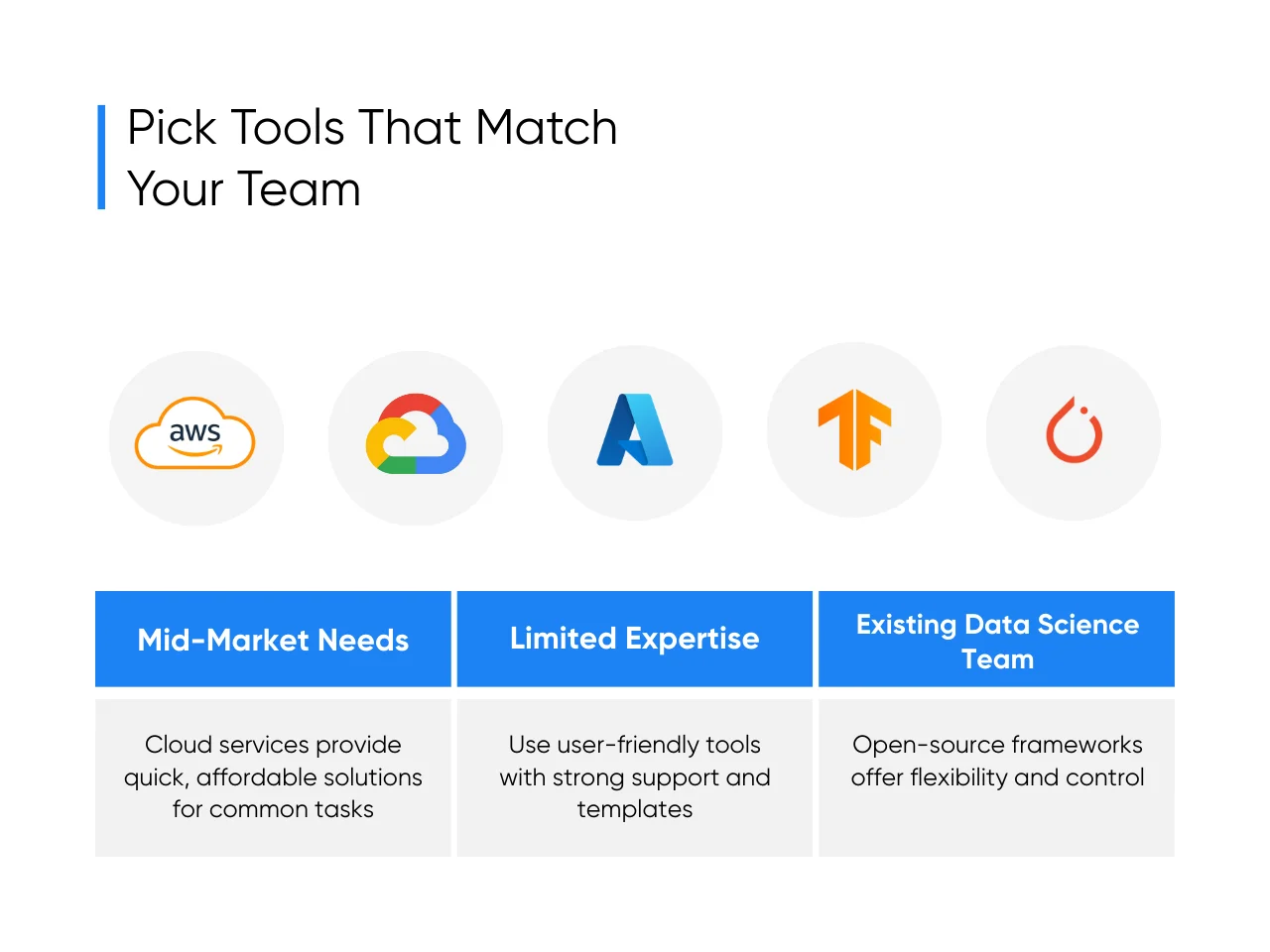
- For most mid-market needs (chatbots, forecasting, image recognition): Cloud services from AWS, Google, or Azure do the job. They’re affordable, secure, and easy to spin up for pilots. You can get something working in weeks, not months.
- If your team doesn’t have much in-house expertise: Lean on tools with strong documentation, built-in templates, and responsive support. They’ll help you avoid long stalls while people try to figure out the basics.
- If you already have a data science bench: Open-source frameworks like TensorFlow or PyTorch give you more flexibility for feature engineering. You control the fine-tuning, and you’re not locked into one vendor’s roadmap.
The rule of thumb: pick what your team can use today and grow into tomorrow. The flashiest platform is worthless if it sits on the shelf, while a simpler tool that your people actually adopt delivers real wins.
4. Decide When to Build and When to Buy
This is one of the biggest forks in the road: do you build a custom solution or buy something off the shelf? Both paths work in your digital transformation. You just need to know when each makes sense:
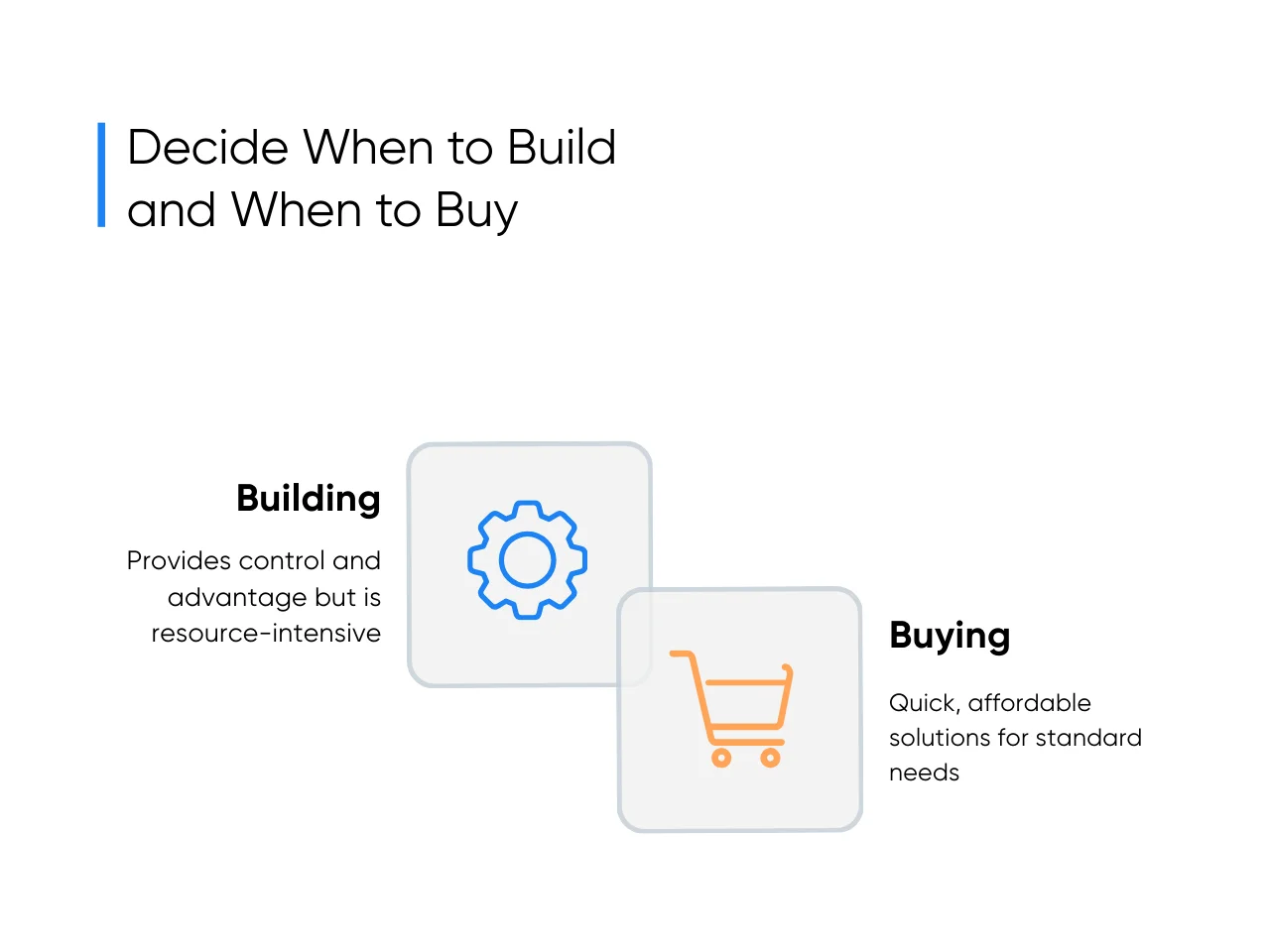
- Building: Gives you control and differentiation, but it’s resource-heavy. It’s worth it when the problem is core to your business or when an edge in performance gives you a competitive moat. A logistics company might invest in custom route optimization, because shaving minutes off every delivery adds up to millions saved annually.
- Buying: Shines when the need is standard. Fraud detection, chatbots, and sales forecasting all have mature, pre-packaged solutions you can plug in quickly. They’re cheaper, faster to deploy, and good enough for problems that don’t define your market position.
Most mid-market leaders land in the middle: a hybrid approach. Buy for the quick wins that prove value to stakeholders. Build only where you’ll see long-term advantage and where an off-the-shelf solution falls short. That balance lets you show ROI fast without burning resources.
The key is to be intentional. Don’t build because it feels more impressive, and don’t buy just to save time. Match the choice to the business impact of your strategic initiatives.
5. Test Small, Deploy Carefully
Training a machine learning model is only the first step. The real test comes when it meets messy, real-world data and the people who have to use it. That’s why the smartest approach is to roll out in controlled pilots, not company-wide launches.
Start small: one product line, one team, one region. It contains risks while providing you with clear feedback. You’ll be able to identify and fix quirks in the workflow before they become expensive mistakes.
And remember, success isn’t just accuracy on a dashboard. It’s adoption. Look for signs like:
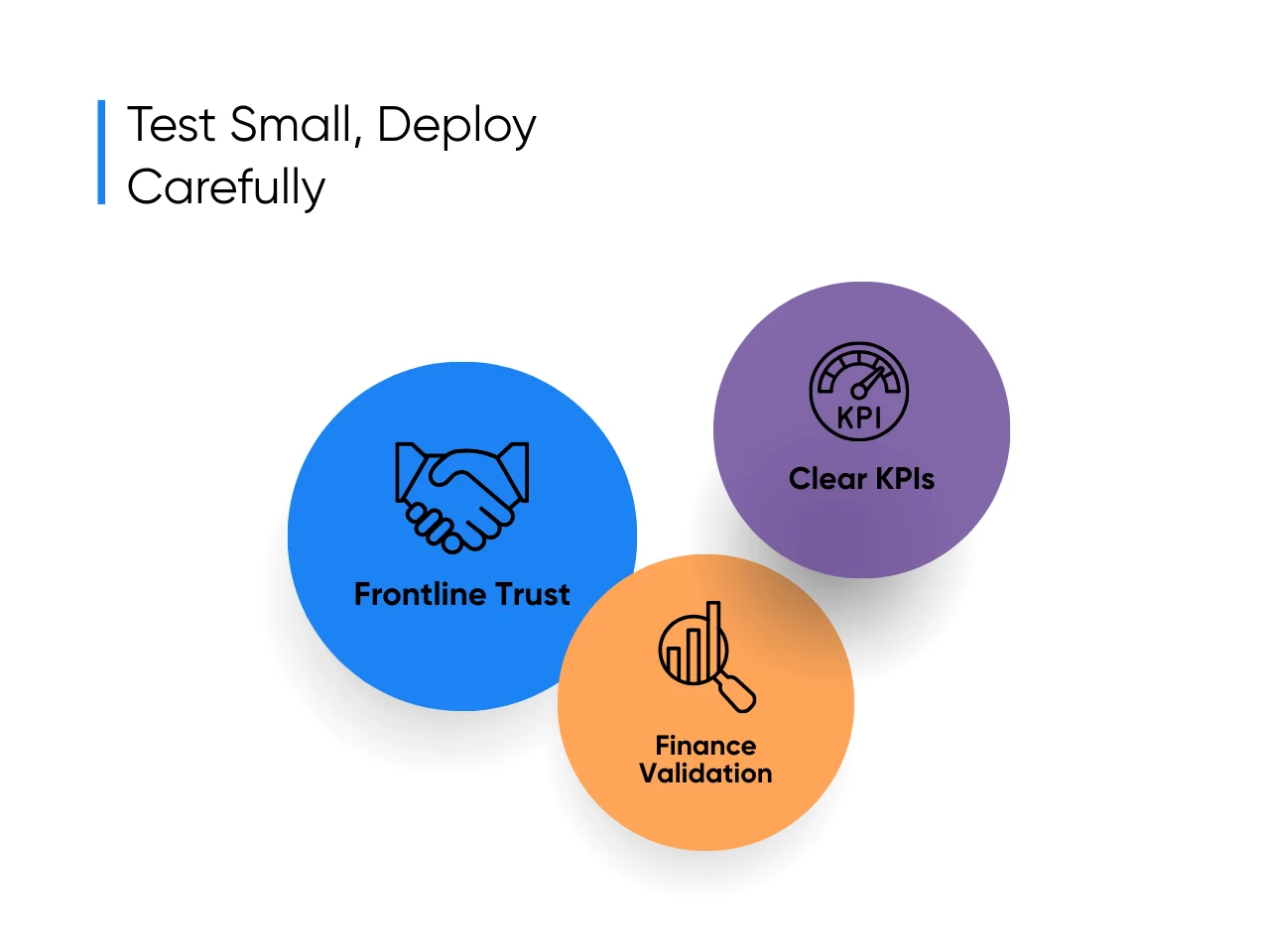
- Frontline Trust: Do staff actually use the model’s recommendations, or do they ignore them?
- Finance Validation: Are there hard numbers in cost savings or revenue gains, not just another line item?
- Clear KPIs: Are you tracking outcomes that tie directly to business goals, not just technical metrics?
Tight feedback loops and KPIs grounded in business outcomes will tell you when you’re ready to scale.
These five moves will help you focus on the right problems, keep your data clean, build only where it pays off, and test safely. That way, you can implement machine learning successfully and turn it into a lasting business advantage.
Overcoming Common Machine Learning Implementation Challenges
ML playbook might look clean on paper, but the reality is messy data, skeptical teams, and costs that can creep up if you’re not careful. There are five hurdles mid-market leaders often run and how to get past them:
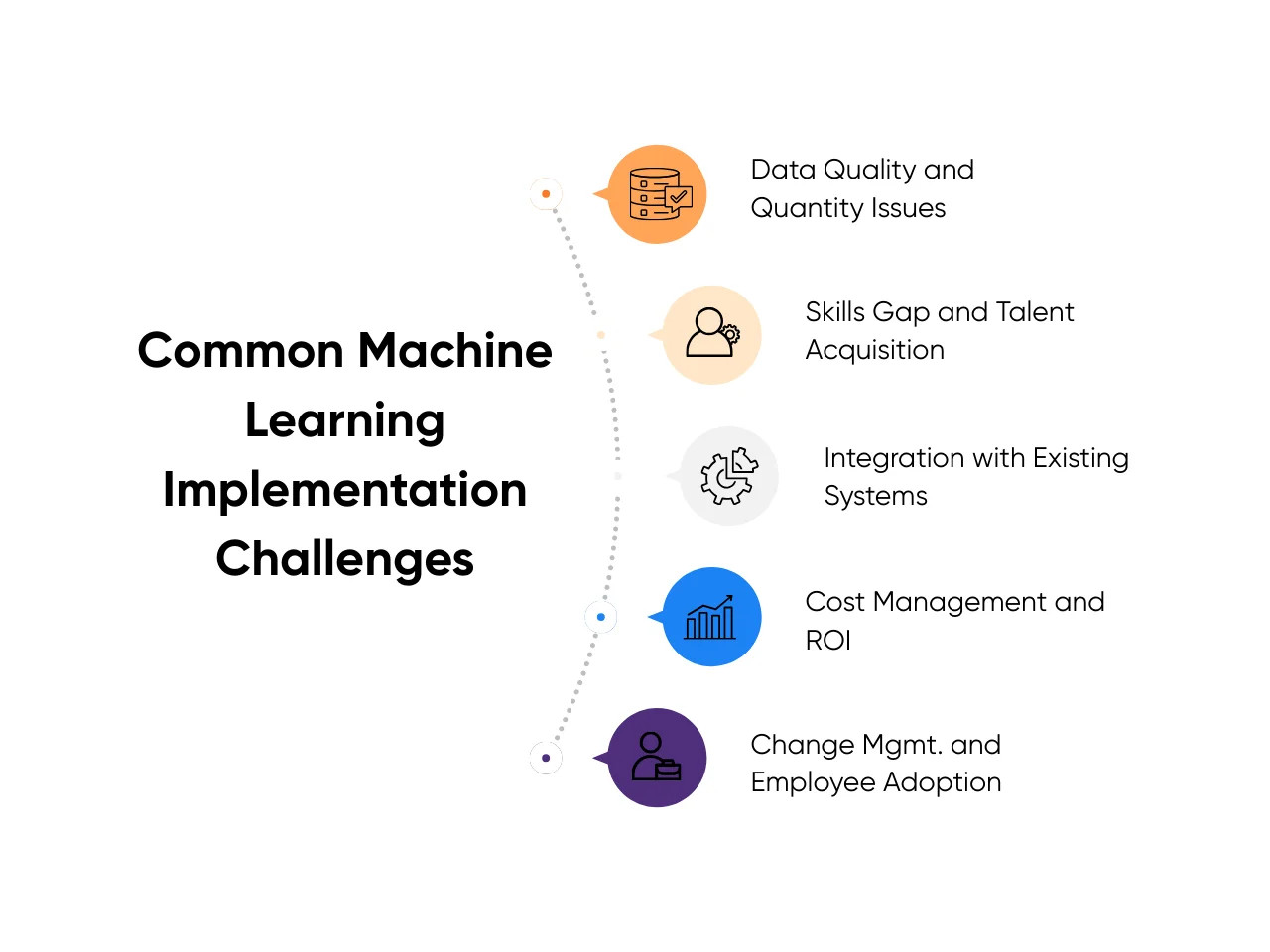
Data Quality and Quantity Issues
Garbage in, garbage out. Even the best model can’t overcome bad input. If customer records are full of duplicates or your sensors only capture half the signals, results will be off. And trust in ML will erode fast.
Here's a better approach:
- Start small with the cleanest dataset you have.
- Standardize how data gets entered (sales reps using the same fields, ops logging issues consistently).
- Use lightweight prep tools to handle deduping and formatting.
- Prove value on solid data first, then expand to bigger or messier sets.
It’s better to win early with a narrow but clean use case than to overreach and fail on noise.
Skills Gap and Talent Acquisition
ML talent is scarce and expensive. Most mid-market firms can’t hire a full data science team overnight, and waiting to “staff up” often means projects never leave the whiteboard.
Here's how you can move forward:
- Upskill your own people: Analysts, engineers, even ops staff who know your business context can be trained to handle the basics.
- Bring in specialists selectively: Lean on outside experts like Aloa for the heavy lifting, like model design, architecture, or integration, so your internal team can stay focused on business priorities.
- Build gradually: Over time, form an internal bench so knowledge stays in-house.
The key is momentum. Don’t let hiring bottlenecks stall progress, and pair onboarding with Coursera AI courses. Blend upskilling with outsourcing so you’re showing results in months, not waiting years for a full data science team.
Integration with Existing Systems
Great models fail when they don’t fit into day-to-day workflows. A churn-prediction tool won’t help if sales reps have to log into a separate dashboard they’ll never check. The value only shows up when ML outputs blend into the tools people already use. Here's how:
- Plug insights into existing systems (CRM, ERP, ticketing).
- Keep recommendations in context, not on separate dashboards.
- Start with API connectors or middleware for quick integration.
- Invest in deeper connections once the workflow proves itself.
That way, reps see insights inside their CRM, ops teams get alerts in their ERP, and no one has to juggle another login.
Cost Management and ROI
If projects drag on, you risk drying up funds and eroding user trust. So the smarter path is to track your results closely:
- Start with small pilots tied to clear KPIs (e.g., cut ticket response times by 20% in three months).
- Prove value in one area before expanding.
- Bake in 20–30% of upfront cost for maintenance and updates.
- Track wins in business terms, not just technical accuracy.
As a result, budget holders see faster response times or higher sales, and know the spend is paying off.
Change Management and Employee Adoption
The tech might be 99% ready, but people often aren’t. Employees worry ML will replace them, or they don’t trust what the model spits out. Here’s how you can help your team:
- Frame ML as support, not substitution.
- Keep humans in the loop for tricky cases so they see the model as a partner.
- Share proof points widely, like how automation freed the support team from 10 hours of ticket triage a week, or how predictive maintenance avoided a costly breakdown on the shop floor.
When a rep sees tickets cleared faster or a tech sees fewer midnight callouts, they stop questioning the model and start leaning on it.
Overcoming these hurdles isn’t about perfection; it’s about steady progress. Solve one at a time, show measurable wins, and confidence grows. At Aloa, we help mid-market teams do just that: clean up messy data, bridge skill gaps, and fold ML into existing workflows without blowing the budget. It’s a safer way to prove value fast and build lasting trust across the business.
Measuring Success: KPIs and Performance Metrics
Shipping an ML model doesn’t automatically lead to success. True success comes when you can point to shorter response times, lower churn, or steadier output, and have the numbers to back it up.
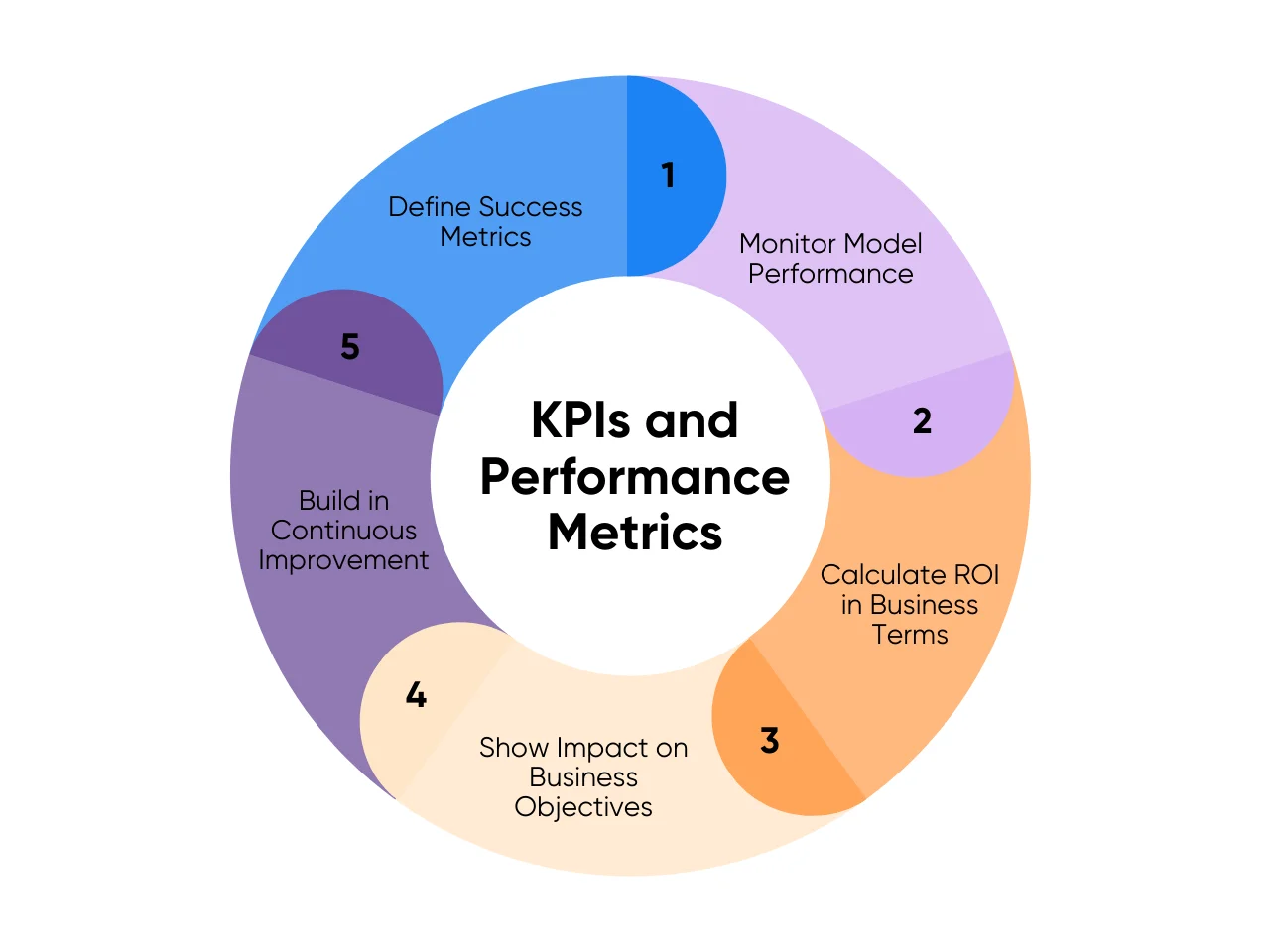
- Define success metrics up front: Decide what “good” looks like before the project starts. If the goal is customer service, track average handle time or first-response rate. If it’s maintenance, track unplanned downtime hours. Success metrics should line up with KPIs your CFO already tracks, not a new set of ML-only numbers.
- Monitor model performance: Accuracy isn’t enough; you need reliability over time. Watch for drift, where predictions degrade as customer behavior or market conditions change. For example, a demand-forecasting model trained on pre-holiday data might stumble in January. Schedule regular checks and retraining so the model stays useful.
- Calculate ROI in business terms: Talk about savings and revenue, not just precision scores. Instead of “the model is 92% accurate,” say “support costs dropped 18% last quarter” or “forecasting errors fell by a third, saving $2M in excess inventory.” Numbers tied to real dollars keep finance and leadership on board.
- Show impact on business objectives: Connect the dots from the model to outcomes that matter. Did customer lifetime value rise because retention improved? Did order fulfillment speed up because inventory stayed balanced? Did fraud losses shrink because detection caught more suspicious activity? ML earns trust when leaders see its impact on the scoreboard.
- Build in continuous improvement: Models aren’t “set and forget.” Keep feedback loops open. Retrain on fresh data, refine features, and validate with new business inputs. Even small updates (a quarterly retrain, a tweak to input data) can stretch the lifespan of a model and keep performance strong.
When you measure ML the right way, you don’t just get cleaner dashboards. You get proof that wins are real, momentum for the next project, and a story leadership can stand behind when budgets are on the line.
Key Takeaways
For businesses, we need to solve the right problems and prove ROI. Looking ahead, machine learning for business will need to be deployed responsibly. The simplest entry point is a focused pilot: pick one KPI-driven problem, audit the data you’ll need, choose a tool your team can run, define success up front, and plan for a feedback loop to refine as you go.
At Aloa, our mission is to make emerging tech practical and accessible for mid-market teams. We help leaders move from strategy to execution without wasted spend, and we share what we learn freely. Join our Discord community to swap ideas with peers, or subscribe to our Byte-Sized AI newsletter for plain-language insights you can act on.
And when you’re ready to take the next step, contact us to shortlist two pilot use cases and map out a rollout plan your team can actually run with.
Machine Learning for Business FAQs
1. What’s the typical timeline and budget for implementing machine learning in a mid-sized business?
Most teams start small. At Aloa, a proof of concept takes 6–8 weeks and runs about $20K–$30K, which is enough to test feasibility and deliver a working prototype. A production-ready build usually takes 3–4 months, with budgets in the $50K–$150K range once integration and training are included. Larger, multi-system rollouts can run $150K–$300K+ over six months or more. No matter the size, it’s smart to set aside 20–30% of upfront costs for ongoing maintenance and updates.
2. How do we identify which business problems are suitable for machine learning?
The best candidates usually check three boxes: they’re repetitive, data-rich, and measurable. Ticket routing, demand forecasting, and fraud flagging are all strong fits. In each case, humans already make solid calls, but automation can cut time, reduce errors, or free up bandwidth. Problems that rely on creativity, fuzzy judgment, or thin data don’t work as well. If success can’t be tied to dollars saved, hours reduced, or errors avoided, it’s not the right fit.
3. Should we build machine learning capabilities in-house or outsource?
For most mid-market firms, the answer isn’t one or the other. It’s both. Outsource early projects to specialists who can deliver quick wins. Use cloud-based ML tools for standard needs like chatbots or analytics. Then, as your team gains confidence, build in-house skills for the strategic systems you’ll want to own long-term. With Aloa’s ML development services, you get a head start: we handle the heavy lifting, walk your team through the process, and leave you with not just working solutions, but stronger internal capability.

